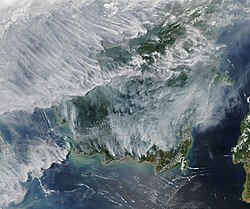
| Southeast Asian haze series |
|---|
 |
| History |
| Key topics |
| Responses |
| See also |
|
|
Peat swamp forests are tropical moist forests where waterlogged soil prevents dead leaves and wood from fully decomposing. Over time, this creates a thick layer of acidic peat.[1] Large areas of these forests are being logged at high rates.
Peat swamp forests are typically surrounded by lowland rain forests on better-drained soils, and by brackish or salt-water mangrove forests near the coast.
They are a kind of peatland, which store and accumulate vast amounts of carbon as soil organic matter—much more than forests on mineral soil (i.e. non-peatland) contain. Peat formation is a natural carbon sink; because the decomposition of the organic matter is slower than its production rate, the surplus accumulates as peat. Their stability has important implications for climate change; they are among the largest near-surface reserves of terrestrial organic carbon.[2] Tropical peat swamp forests, which have ecological importance, are one of the most threatened, yet least studied and most poorly understood biotypes.
Since the 1970s, tropical peat swamp forest deforestation and drainage have greatly increased in South East Asia.[3] In addition, El Niño Southern Oscillation (ENSO) drought and large-scale fires are accelerating peatland devastation. Peat fires, drainage and deforestation enhances the decomposition of soil organic matter, increasing the release of stored carbon into the atmosphere as carbon dioxide.[4]
Tropical peat swamp forests are home to thousands of animals and plants, including many rare and critically endangered species such as the orangutan and Sumatran tiger, whose habitats are threatened by peatland deforestation.[5]
- ^ Cite error: The named reference
:03was invoked but never defined (see the help page). - ^ Page, Susan E.; Rieley, John O.; Banks, Christopher J. (1 February 2011). "Global and regional importance of the tropical peatland carbon pool". Global Change Biology. 17 (2): 798–818. Bibcode:2011GCBio..17..798P. doi:10.1111/j.1365-2486.2010.02279.x. ISSN 1365-2486. S2CID 86121682.
- ^ Murdiyarso, Daniel; Lilleskov, Erik; Kolka, Randy (1 April 2019). "Tropical peatlands under siege: the need for evidence-based policies and strategies". Mitigation and Adaptation Strategies for Global Change. 24 (4): 493–505. doi:10.1007/s11027-019-9844-1. ISSN 1573-1596.
- ^ Bell, Loren (20 July 2014). "What is peat swamp, and why should I care?". Mongabay Environmental News. Retrieved 19 September 2023.
- ^ "Peatland Treasures – Wetlands International". wetlands.org. Retrieved 15 April 2018.